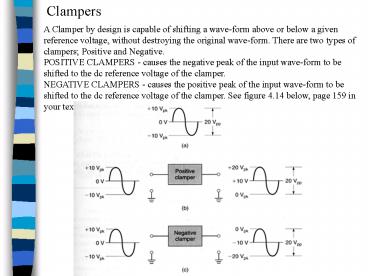Clampers - PowerPoint PPT Presentation
1 / 8
Title: Clampers
1
Clampers
A Clamper by design is capable of shifting a
wave-form above or below a given reference
voltage, without destroying the original
wave-form. There are two types of clampers
Positive and Negative. POSITIVE CLAMPERS - causes
the negative peak of the input wave-form to be
shifted to the dc reference voltage of the
clamper. NEGATIVE CLAMPERS - causes the positive
peak of the input wave-form to be shifted to the
dc reference voltage of the clamper. See figure
4.14 below, page 159 in your text.
2
Clampers
Previously we have discussed the calculations
involving dc levels of ac sine waves. When
dealing with a sine wave that is not rectified
and lies completely above or below a 0 V, the
value of Vave is simply that which lies in the
middle. (Current is only flowing in one
direction). However, it must be noted that the ac
values will still be Vpp and Vrms as they were
before.
3
Clampers
The operation of the clamper is shown below in
figure 4.15, page 160. It appears very similar to
the shunt clipper with the addition of the input
capacitor. There are two time constants that we
are dealing with here Charge and Discharge
constants. For charging ? RD1C1 while Tc ?
5(RD1C1) For discharging ? RLC1 while Td ?
5(RLC1) NOTE The charge time is significantly
less than the discharge time.
4
Clampers
Square Wave Response (IDEAL) figure 4.16, page
162. When D1 is forward biased the capacitor
charges at a rate of Tc ? 5(RD1C1) up to the
applied voltage of 5V. With the applied voltage
ideally applies across the capacitor C1, the load
voltage realizes a peak value of 0Vpk. The
capacitor begins at a value of 0V and discharges
negatively as the input wave-form switches to
full negative potential (square wave input).
Since there is a series summing between the
capacitor and the source voltage, the load will
see a range of 0 to -10V. If the capacitor does
not have a long enough discharge time you will
see an effect where the peak value has a definite
slope to it. (saw-tooth) See next slide for
figure 4.16 See two slide away for saw-tooth
effect.
5
(No Transcript)
6
(No Transcript)
7
Biased Clampers
Biased Clampers allow for the dc reference
voltage to be that other than just 0V. See figure
4.19 below, page 163.
8
Clampers
Previously































